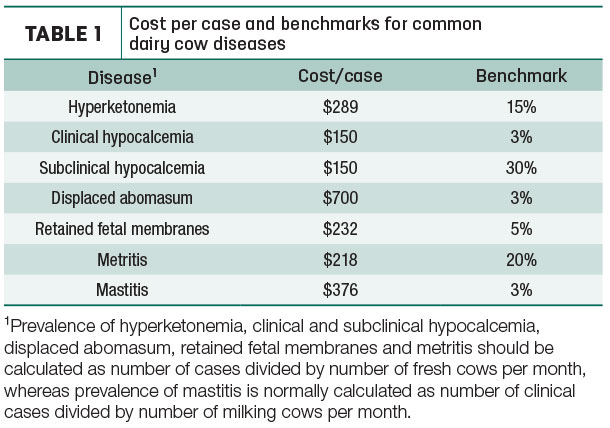Cows transitioning from dry to lactating status face physiological, metabolic, endocrine and environmental changes. Plus, in early lactation, cows’ energy demands jump 300 percent, and calcium requirements climb more than 65 percent.
“Cows simply do not have enough appetite after calving to meet these nutrient requirements,” said Luciano Caixeta, University of Minnesota College of Veterinary Medicine assistant professor, at the 2018 Dairy Cattle Reproduction Annual Meeting. “This leads to negative balance – for both energy and major minerals, especially calcium.”
“While dairy managers often spend significant time analyzing the transition period (three weeks before and three weeks after parturition), metabolic changes start earlier and have carryover effects beyond this period,” explained Caixeta. In addition to milk production, preventing negative energy balance helps support fetal growth and colostrum quantity and quality.
“We need strategies to improve dry matter intake (DMI), especially after calving,” said Caixeta. Increasing DMI addresses the appetite issue mentioned earlier. However, remember to control energy intake during the far-off dry period to prevent excess body condition.
Monitor fresh cows daily
A “rough” transition period typically correlates with a rough lactation (and reproductive performance). Thus, carefully monitor (daily screening) cows the first two weeks postpartum to detect metabolic diseases, which may hamper milk production, immunity and fertility. Identifying health deficiencies helps dairy producers discover underlying metabolic problems or management inadequacies.
Metabolic disorders such as hypocalcemia, hyperketonemia, displaced abomasum and fatty liver play significant roles in transition cow health and a dairy’s bottom line (see Table 1).

Caixeta reported that proper nutritional management during the late stages of the previous lactation and dry period can decrease the prevalence of metabolic disorders during early lactation.
Diseases, such as those mentioned, cause inflammation and tissue damage. To address these impairments, nutrients are used to control infection and repair damaged tissue rather than being used to support milk production, growth and reproduction.
Adjust dietary DCAD
Along with optimal cow comfort, nutrition plays a key role in preventing metabolic disorders and optimizing transition cow health. Incorporating anionic salts is a nutrition strategy that creates a negative dietary cation-anion difference (DCAD). This causes blood pH to drop, resulting in a low-grade calcium release (from bones into extracellular fluid) to balance excessive anion concentration in circulation. Kidneys excrete mobilized calcium until parturition, when it is used to fulfill elevated calcium needs for milk production.
Feeding a negative-DCAD diet (-10 to -15 meq per 100 grams ration dry matter) for the three weeks prior to calving improves cow health and performance in the following lactation. Studies have shown feeding a negative-DCAD ration reduced the prevalence of subclinical hypocalcemia at day zero and one day in milk (20.0 percent and 34.3 percent).
On the flip side, feeding a positive-DCAD ration showed significantly higher levels of subclinical hypocalcemia: 69.3 percent and 76.5 percent on day zero and day one in milk, respectively. Similarly, incidence of clinical hypocalcemia (milk fever) was zero percent with the negative-DCAD ration, compared with 23.1 percent with the positive-DCAD ration.
Furthermore, two 2018 meta-analyses illustrated the importance of feeding a negative-DCAD diet three weeks before parturition. Feeding a negative-DCAD ration improves calcium metabolism around calving, reduces the risk of milk fever and uterine diseases, and fosters lactation performance. These improvements set up cows for future reproductive success.
“When feeding anionic salts during the pre-fresh period, it is extremely important to monitor if mineral supplements are creating expected blood acidification,” Caixeta said. Monitor acidification (caused by feeding anionic salts) by measuring individual cow urine pH. Optimal urine pH for dry cows (when consuming anionic salts) is between 6.0 and 6.7. Caixeta noted that cows should be consuming anionic salts for at least two days before assessing their effect on urine pH.
Supplementing calcium
Proactive calcium supplementation in early lactation also helps prevent hypocalcemia. Caixeta recommended giving calcium boluses orally rather than giving calcium intravenously. This recommendation applied to cows that are standing (experiencing subclinical hypocalcemia). Clinical cases should receive calcium intravenously. Research done in 2012 and 2014 showed calcium boluses elevate blood calcium concentration without elevating blood calcium concentrations to near cardio-toxic levels.
Several studies have shown calcium supplementation after parturition positively influences a dairy’s net margin because this strategy is associated with increased health and production in high-yielding dairy cows, especially for older and lame cows. Conversely, studies done in 2015, 2016 and 2018 found few benefits of giving fresh cows oral calcium across the board. These studies indicated oral calcium supplementation is not recommended for primiparous cows. Consult your veterinarian or nutritionist before implementing this strategy.
To prevent significant culling and cow mortality during the first 60 days in milk, prevent transition period metabolic diseases. “Premature culling and cow death result in substantial financial losses,” Caixeta said. “Plus, these issues are important cow welfare concerns. To make improvements in these areas, consistently record the reasons why cows leave the herd. This will help managers recognize trends and identify transition cow management inadequacies.” ![]()
References omitted but are available upon request. Click here to email an editor.
JoDee Sattler contributed this on behalf of the Dairy Cattle Reproduction Council (DCRC).





